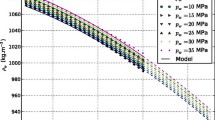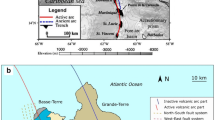Abstract
The Kakkonda geothermal reservoir, Japan, is a typical high-temperature liquid-dominated geothermal reservoir, except for its distinctive two-layered temperature structure. It has a shallow permeable reservoir of 230–260°, and a deep less permeable reservoir of 350–360°. Geology and hydrology indicate that the shallow reservoir is one to two orders of magnitude more permeable than the deep reservoir, but that the two reservoirs communicate. It has been widely assumed in engineering and scientific circles that the connection between the two reservoirs is a zero or low permeability barrier to fluid flow. We show that this hypothesis is untenable, based on both physical evidence and numerical simulation. We numerically model the evolution of the geothermal system as it heats after emplacement of an intrusion. The two-layered temperature structure is found to be a consequence of the permeability difference, i.e. the two-layered permeability structure.
Similar content being viewed by others
References
Allegrini, G., Cappetti, G. and Sabatelli, F.: 1995, Geothermal development in Italy: country update report, Proc. World Geotherm. Cong., 1995, Florence, Italy, 1, 201–208.
Bodvarsson, G. S.: 1988, Reservoir development strategy for hot water reservoirs with emphasis on reservoir modeling, Bull. Geotherm. Resour. Council 17, 69–90.
Bodvarsson, G. S., Pruess, K., Stefansson, V. and Eliasson, E. T.: 1984, The Krafla geothermal field, Iceland, 2. The natural state of the system, Water Resour. Res. 20, 1531–1544.
Cathles, L. M.: 1977, An analysis of the cooling of intrusive by ground-water convection which includes boiling, Econ. Geol. 72, 804–826.
Cheshire, I. M., Appleyard, J. R., Banks, D., Crozier, R. J. and Holmes, J. A.: 1980, An efficient fully implicit simulator, paper EUR-179, presented at EUROPEC 80 Conf., London, 1980.
Coats, K. H.: 1977, Geothermal reservoir modeling, paper SPE-6892, presented at the 52nd Annual Fall Technical Conf. Soc. Petrol. Engnrs, Denver, Oct. 9–12, 1977.
Cox, B. L. and Pruess, K.: 1990, Numerical experiments on convective heat transfer in water-saturated media at near-critical conditions, Transport in Porous Media 5, 299–323.
Doi, N., Muramatsu, Y., Chiba, Y. and Tateno, M.: 1988, Geological analysis of the Kakkonda geothermal reservoir, Proc. Int. Symp. Geotherm. Energy, 1988, Kumamoto and Beppu, Japan, pp. 522–525.
Doi, N., Kato, O., Kanisawa, S. and Ishikawa, K.: 1995, Neo-tectonic fracturing after emplacement of Quaternary granitic pluton in the Kakkonda geothermal field, Japan, Trans. Geotherm. Resour. Council 19, 297–303.
Garg, S. K. and Kassoy, D. R.: 1981, Convective heat and mass transfer in hydrothermal systems, In: L. Rybach and L. J. P. Muffler (eds.), Geothermal Systems, Wiley, 37–76.
Gianelli, G., Puxeddu, M., Batini, F., Bertini, G., Dini, I., Panderi, E. and Nicolich, R.: 1988, Geological model of a young volcano-plutonic system: the geothermal region of Monte Amiata (Tuscany, Italy), Geothermics, 17, 27–36.
Gilman, J. R. and Kazemi, H.: 1983, Improvements in simulation of naturally fractured reservoirs, Soc. Pet. Eng. J. August, pp. 695–707.
Hanano, M.: 1995, Hydrothermal convection system of the Kakkonda geothermal field, Japan, Proc. World Geotherm. Cong., 1995, Florence, Italy, 3, 1629–1634.
Hanano, M. and Seth, M. S.: 1995, Numerical modeling of hydrothermal convection systems including super-critical fluid, Proc. World Geotherm. Cong., 1995, Florence, Italy, 3, 1681–1686.
Hanano, M. and Takanohashi, M.: 1993, Review of recent development of the Kakkonda deep reservoir, Japan, Proc. 18th Workshop Geotherm. Res. Eng., Stanford Univ., pp. 29–34.
Hayba, D. O. and Ingebritsen, S. E.: 1994, Flow near the critical point: examination of some pressure-enthalpy paths, Proc. 19th Workshop Geotherm. Res. Eng., Stanford Univ., pp. 83–89.
International Formulation Committee: 1967, A Formulation of the Thermodynamic Properties of Ordinary Water Substance, IFC Secretariat, Dusseldorf, Germany.
Japan Society of Mechanical Engineers: 1981, 1980 SI JSME Steam Tables, Japan Society of Mechanical Engineers.
Kajiwara, T., Hanano, M., Ikeuchi, K. and Sakagawa, Y.: 1993, Permeability structure at the Kakkonda geothermal field, Iwate Prefecture, Japan, 1993 Annual Meeting, Geothermal Research Society of Japan, Abstracts and Programs, B30. (in Japanese)
Kasai, K.: 1993, An approach to water-rock interaction in the Kakkonda geothermal reservoir, 1993 Annual Meeting, Geothermal Research Society of Japan, Abstracts and Programs, A13. (in Japanese)
Kato, O. and Doi, N.: 1993, Neo-granitic pluton and later hydrothermal alteration at the Kakkonda geothermal field, Japan, Proc. 15th New Zealand Geotherm. Workshop, Auckland Univ., pp. 155–161.
Kato, O., Doi, N., Akazawa, T., Sakagawa, Y., Yagi, M. and Muraoka, H.: 1995, Characteristics of fractures based on FMI logs and cores in well WD-1 in the Kakkonda geothermal field, Japan, Trans. Geotherm. Resour. Council 19, 317–322.
Kissling, W. M.: 1995, Extending MULKOM to super-critical temperature and pressures, Proc. World Geotherm. Cong., 1995, Florence, Italy, 3, 1687–1690.
Komatsu, R. and Muramatsu, Y.: 1994, Fluid inclusion study of the deep reservoir at the Kakkonda geothermal field, Japan, Proc. 16th New Zealand Geotherm. Workshop, Auckland Univ., pp. 91–96.
McGuinness, M., White, S., Young, R., Ishizaki, H., Ikeuchi, K. and Yoshida, Y.: 1995, A model of the Kakkonda geothermal reservoir, Geothermics, 24, 1–48.
McKibbin, R. and McNabb, A.: 1993, Modeling the phase boundaries and fluid properties of the system H2O-NaCl at high temperatures and pressures, Proc. 15th New Zealand Geotherm. Workshop, Auckland Univ., pp. 267–273.
McKibbin, R. and McNabb, A.: 1995a, From magma to groundwater: the brine connection, Proc. World Geotherm. Cong., 1995, Florence, Italy, 2, 1125–1130.
McKibbin, R. and McNabb, A.: 1995b, Mathematical modeling of non-condensible gases in hot dense brines: the system H2O-NaCl-CO2, Proc. 17th New Zealand Geotherm. Workshop, Auckland Univ., pp. 255–262.
Nakamura, H.: 1986, Flow of hot water in geothermal reservoir, Kakkonda, northeast Japan, Proc. Int. Sympo. “Geothermal Energy Development and Advanced Technology”, November 6–8, 1986, Sendai, Japan, pp. 209–215. (in Japanese with English abstract).
Nakamura, H. and Sumi, K.: 1981, Exploration and development at Takinoue, Japan, In: L. Rybach and L. J. P. Muffler (eds.), Geothermal Systems, Wiley, pp. 247–272.
Norton, D. and Knight, J.: 1977, Transport phenomena in hydrothermal systems: cooling plutons, Am. J. Sci. 277, 937–981.
Oldenburg, C., Pruess, K. and Lippmann, M.: 1995, Heat and mass transfer in hypersaline geothermal systems, Proc. World Geotherm. Cong., 1995, Florence, Italy, 3, 1647–1652.
Oppe, T. C., Joubert, W. D. and Kincaid, D. R.: 1988, NSPCG User's Guide, Center for Numerical Analysis, University of Texas, Austin, Texas.
Price, H. S. and Coats, K. H., 1973, Direct methods in reservoir simulation, paper SPE-4278, presented at the 3rd SPE Symposium on Numerical Simulation, Houston, Jan. 11–12, 1973.
Pruess, K. and Narasimhan, T. N.: 1985, A practical method for modeling fluid and heat flow in fractured porous media, Soc. Pet. Eng. J., February, pp. 14–26.
Quijano-León, J. L. and Negrín, L. C. A. G.: 1995, Present situation of geothermics in Mexico. Proc. World Geotherm. Cong., 1995, Florence, Italy, 1, 245–250.
Reyes, A. G.: 1990, Petrology of Philippine geothermal systems and the application of alteration mineralogy to their assessment, J. Volc. Geotherm. Res. 43, 279–309.
Roberts, P. J., Lewis, R.W., Carradori, G. and Peano, A.: 1987, An extension of the thermodynamic domain of a geothermal reservoir simulator, Transport in Porous Media, 2, 397–420.
Sakagawa, Y., Takahashi, M., Hanano, M., Ishido, T. and Demboya, N.: 1994, Numerical simulation of the Mori geothermal field, Japan, Proc. 19th Workshop Geotherm. Res. Eng., Stanford Univ., pp. 171–178.
Sato, K.: 1982, Analysis of geological structure in the Takinoue geothermal area, J. Geotherm. Res. Soc. Jap. 3, 135–148.
Seth, M. S. and Hanano, M.: 1995, An efficient solution procedure for multiple interacting continua flow, Proc. World Geotherm. Cong., 1995, Florence, Italy, 3, 1625–1628.
Shook, G. M.: 1995, Development of a vapor-dominated reservoir with a ‘high-temperature’ component, Geothermics, 24, 489–505.
Stanford Geothermal Program: 1980, Proc. Special Panel on Geothermal Model Intercomparison Study, SGP-TR-42, Stanford Univ.
Steingrimsson, B., Gudmundsson, A., Franzson, H. and Gunnlaugsson, E.: 1990, Evidence of a super-critical fluid at depth in the Nesjavellir field, Proc. 15th Workshop Geotherm. Res. Eng., Stanford Univ., pp. 81–88.
Takahashi, M., Tateno, M., Kondo, T., Suzuki, I., Shigehara, S., Yagi, M., Muraoka, H. and Niitsuma, H.: 1995, Micro-earthquake monitoring and triaxial drill-bit VSP in NEDO ‘deep-seated geothermal reservoir survey’ in Kakkonda, Japan, Trans. Geotherm. Resour. Council 19, 371–376.
Thompson, R. C.: 1989, Structural stratigraphy and intrusive rocks at The Geysers geothermal field, Trans. Geotherm. Resour. Council 13, 481–485.
Tosha, T., Sugihara, M. and Nishi, Y.: 1993, Microearthquake activity at the Kakkonda geothermal field in Japan, Proc. 15th New Zealand Geotherm. Workshop, Auckland Univ., pp. 175–179.
Turcotte, D. L. and Schubert, G.: 1982, Geodynamics, Wiley, New York.
Vinsome, P.K. W.: 1976, Orthomin, an iterative method for solving sparse sets of simultaneous linear equations, paper SPE-5729, presented at the 4th SPE symposium on Numerical Simulation, Los Angeles, Feb. 1976.
Walters, M. A., Sternfeld, J. N., Haizlip, J. R., Drenick, A. F. and Combs, J.: 1988, A vapor-dominated reservoir exceeding 600°F at The Geysers, Sonoma county, California, Proc. 13th Workshop Geotherm. Res. Eng., Stanford Univ., pp. 73–81.
Yanagiya, S., Kasai, K., Brown, K. L. and Giggenbach, W. F.: 1996, Chemical characteristics of deep geothermal fluid in the Kakkonda geothermal system, Iwate prefecture, Japan, Chinetsu (J. Jap. Geotherm. Energy Assoc.) 32, 1–18. (in Japanese with English abstract).
Author information
Authors and Affiliations
Rights and permissions
About this article
Cite this article
Hanano, M. A Simple Model of a Two-Layered High-Temperature Liquid-Dominated Geothermal Reservoir as a Part of a Large-Scale Hydrothermal Convection System. Transport in Porous Media 33, 3–27 (1998). https://doi.org/10.1023/A:1006533307354
Issue Date:
DOI: https://doi.org/10.1023/A:1006533307354




